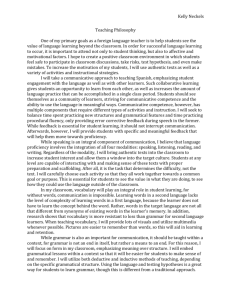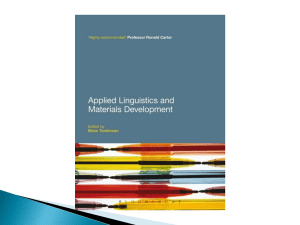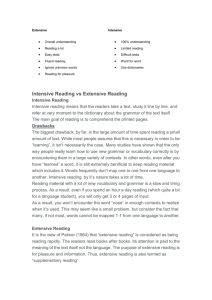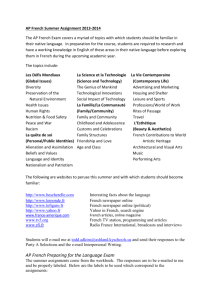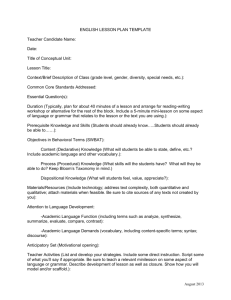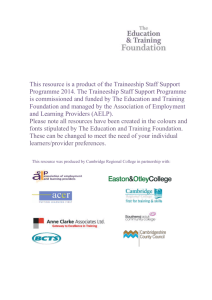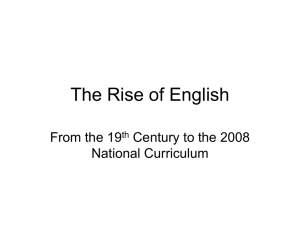Andrea Weatherman Teaching Statement Whatever you think you
advertisement
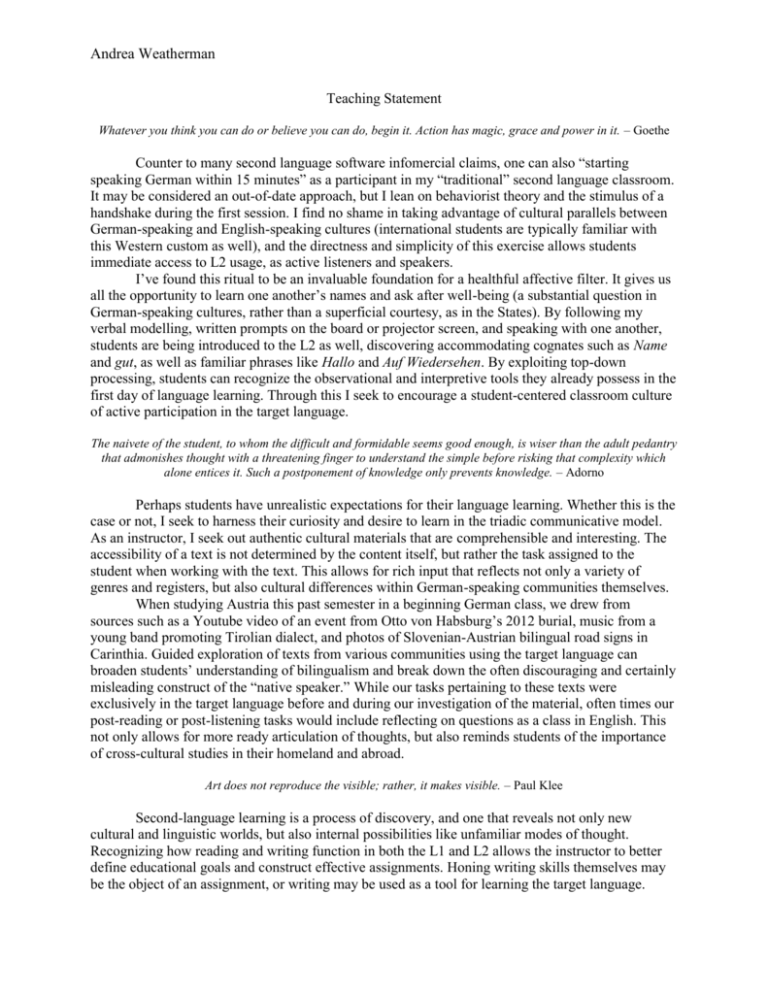
Andrea Weatherman Teaching Statement Whatever you think you can do or believe you can do, begin it. Action has magic, grace and power in it. – Goethe Counter to many second language software infomercial claims, one can also “starting speaking German within 15 minutes” as a participant in my “traditional” second language classroom. It may be considered an out-of-date approach, but I lean on behaviorist theory and the stimulus of a handshake during the first session. I find no shame in taking advantage of cultural parallels between German-speaking and English-speaking cultures (international students are typically familiar with this Western custom as well), and the directness and simplicity of this exercise allows students immediate access to L2 usage, as active listeners and speakers. I’ve found this ritual to be an invaluable foundation for a healthful affective filter. It gives us all the opportunity to learn one another’s names and ask after well-being (a substantial question in German-speaking cultures, rather than a superficial courtesy, as in the States). By following my verbal modelling, written prompts on the board or projector screen, and speaking with one another, students are being introduced to the L2 as well, discovering accommodating cognates such as Name and gut, as well as familiar phrases like Hallo and Auf Wiedersehen. By exploiting top-down processing, students can recognize the observational and interpretive tools they already possess in the first day of language learning. Through this I seek to encourage a student-centered classroom culture of active participation in the target language. The naivete of the student, to whom the difficult and formidable seems good enough, is wiser than the adult pedantry that admonishes thought with a threatening finger to understand the simple before risking that complexity which alone entices it. Such a postponement of knowledge only prevents knowledge. – Adorno Perhaps students have unrealistic expectations for their language learning. Whether this is the case or not, I seek to harness their curiosity and desire to learn in the triadic communicative model. As an instructor, I seek out authentic cultural materials that are comprehensible and interesting. The accessibility of a text is not determined by the content itself, but rather the task assigned to the student when working with the text. This allows for rich input that reflects not only a variety of genres and registers, but also cultural differences within German-speaking communities themselves. When studying Austria this past semester in a beginning German class, we drew from sources such as a Youtube video of an event from Otto von Habsburg’s 2012 burial, music from a young band promoting Tirolian dialect, and photos of Slovenian-Austrian bilingual road signs in Carinthia. Guided exploration of texts from various communities using the target language can broaden students’ understanding of bilingualism and break down the often discouraging and certainly misleading construct of the “native speaker.” While our tasks pertaining to these texts were exclusively in the target language before and during our investigation of the material, often times our post-reading or post-listening tasks would include reflecting on questions as a class in English. This not only allows for more ready articulation of thoughts, but also reminds students of the importance of cross-cultural studies in their homeland and abroad. Art does not reproduce the visible; rather, it makes visible. – Paul Klee Second-language learning is a process of discovery, and one that reveals not only new cultural and linguistic worlds, but also internal possibilities like unfamiliar modes of thought. Recognizing how reading and writing function in both the L1 and L2 allows the instructor to better define educational goals and construct effective assignments. Honing writing skills themselves may be the object of an assignment, or writing may be used as a tool for learning the target language. Andrea Weatherman Likewise, reading tasks may be oriented toward increasing student awareness of monitoring skills or perhaps the emphasis of an assignment is on the linguistic characteristics or cultural content. Some early “writing to learn” activities other than descriptive essays that I’ve found to be successful include creating poems, composing letters, and constructing riddles. However, learning to write is a life-long process and may be pursued in second language study as well. Seeking to share ideas brings with it a critical attitude, as one considers not only a text’s audience, but also the content and form to be presented. It is believed that one “translates” ideas into words when working in the mother-tongue, but ideas must be derived from words when composing in the second language. This inversion is more than simply a cognitive challenge. It is an opportunity to encourage more deliberate reflection on the connection between language usage and thought in composition, and this complements exploration of the final two rhetorical modes: argumentation and exposition. Additionally, early introduction to literary texts for reading is both possible and worth the effort of constructing appropriate tasks for beginning students. I often use excerpts from texts by Erich Kästner and Peter Bichsel for these activities. As stated above, I sometimes include forumdiscussions in the L1 for questions raised by the narrative or implications of the text’s world. In youth we learn in age we understand. – Marie von Ebner-Eschenbach Vocabulary plays a central role in communication, whether in the first or second language, an interpretive or expressive resource. It allows for meaningful communication early on in the process of language learning and can be a part of rich input and output in multiple literacies. Not only does vocabulary serve as the semantic foundation for second language acquisition, but it also parallels the cognitive pattern of a native speaker’s lexicon. Because both native speakers and second language learners store words in the declarative memory structure as described by Ullman’s declarative/procedural model, it is comparatively easy to acquire and retain. Grammar is semantically significant as a framework, but vocabulary is critical throughout the language learning process. Although many curricula continue to stress grammar as the primary organizational feature and object of assessment, recent research has shown that grammar is the first aspect of language learning to atrophy and true understanding comes through indirect exposure to syntactical structures in meaningful contexts. I think it is necessary to provide adult learners with explicit grammar rules at times, but both effective rule to example sessions and guided-inductive lessons depend upon active student participation. The charm of a theory is its refutability. – Nietzsche Many of the approaches I’ve describe above are based on a socio-cultural understanding of learning and may be considered forms of Communicative Language Teaching. However, as shown by my opening remarks, I believe in incorporating teaching techniques that draw upon earlier pedagogical traditions like the Audio-Lingual Method as well. And, while I think it is essential to primarily facilitate class-time in the target language, deliberate and purposeful use of students’ L1 creates space for educational opportunities otherwise unavailable to learners. Because of this, my teaching approach is not static from student to student and class to class. Just as I see sound affective factors as the foundation for a successful semester, I am equally convinced that responsive and respectfully flexible teaching methods are needed to serve students. The exception proves the rule, and I understand the most important teaching principle to be that of adaptation. Ultimately, I hope to provide students with an awareness of the larger global community, the interdependence of language and culture, and the means they have to explore and consider their role in the world.
